CONCEPT MAPPING
AND THE THEORY BEHIND
Concept mapping was developed by the American professor and science researcher Joseph D. Novak and his team from Cornell University in the 1970s. This technique, based on the meaningful learning theory by American psychologist David Paul Ausubel, was used for organizing, structuring and presenting knowledge on a particular subject.
In fact, before Novak developed the idea for the concept map, Ausubel was trying to find a way for presenting information that could help the process of learning. In his theory he declared that “The most important single factor influencing learning is what the learner already knows”.
Later on, Novak expanded Ausubel’s theory and concluded that “Meaningful learning involves the assimilation of new concepts and propositions into existing cognitive structures”.
Particularly, concept mapping is used for learning and teaching. In the beginning, the maps were developed to improve and facilitate the process of learning science. Initially, Novak thought of the concept map as a data analysis tools for his twelve-year study.
More specifically, he introduced the technique of concept mapping in his study as a way to present changes in children’s interpretation of scientific concepts. He taught concept mapping to young students in primary and elementary school as a way to express their answers to elementary questions. These questions were based on different subjects such as ‘What is air?’, ‘What is Earth?’, ‘How does it rain?’, etc.
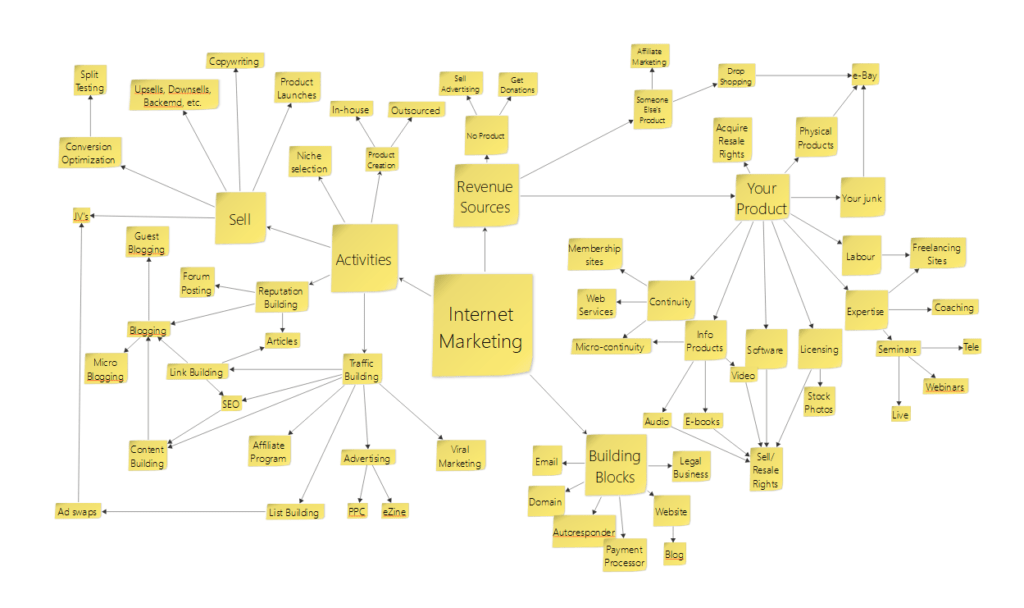
Example of concept map. Free to download from the mind mapping templates page.
Concept maps are a visual illustration of concepts and ideas as a complex structure comprised of boxes or circles that are connected with linking words or phrases arranged around a central concept. Usually structured in a hierarchical relationship, the boxes and circles represent topics and sub-topics that are connected with descriptive expressions in order to define better the mutual relationships.
Through the years, concept mapping has proved itself to be a highly applicable technique that allows people to acknowledge what they know and have learned for a specific discipline. Besides this, it has helped people to orderly portray their thoughts and ideas, analyze what they know and don’t know and, consequently, broaden their existing knowledge. With concept mapping, knowledge can be represented in a structured and hierarchical way. This practical technique through the years has helped students with interpreting and understanding a key concept by viewing a visual illustration of concepts and sub-concepts that link back to the central idea and cross-link themselves.
How is a Concept Map Defined?
Concept maps originate from the philosophy of knowledge called constructivism. Specifically, the followers of this philosophical view believe that knowledge is something that is constructed by learners. Precisely, constructivists consider that existing knowledge is utilized as a model for understanding and learning new knowledge.
Concept maps are visual display ideas, images, words, phrases and sentences that connect one another and present complex concepts based on the knowledge of the mapper. They are created as two-dimensional diagrams comprised of a central general topic that breaks down into more specific subtopics which are interconnected with linking words as an explanation of the connections.
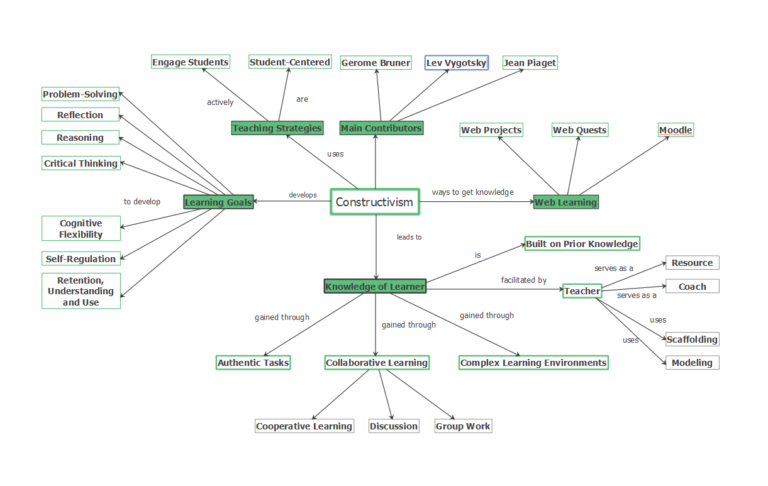
Constructivism concept map
The components that make a concept map are boxes or circles (nodes), lines, labels and arrows (arcs). In the boxes are represented the concepts, with the lines are indicated the relationships between the concepts, the labels explain the nature of the relationships and the arrows describe the directions of all relationships.
More specifically, the linking words which are usually used are: composed of, includes, causes, is influenced by, etc.
Where Concept Mapping Finds Its Use?
In the course of the years, concept mapping found its use in various industries and in different contexts. Today, concept mapping has become a practical method that can be used by students, teachers, newbies, and experts, individually or in a group, as it can serve as a guide towards achieving different objectives.
However, since concept maps were originally created with the idea to help to structure and present knowledge, they are mostly used for educational purposes. These maps could act as a practical teaching and learning tool, but as well as a method for analyzing and evaluating knowledge. While students of any age could benefit from concept mapping as a functional methodology for studying and learning, teachers could benefit as it allows them to notice problems in the course of learning and memorizing information, as well as to adapt their teaching lessons on students’ knowledge.
To conclude, in educational settings, concept maps can be utilized by both students and teachers. First, they help students to learn more efficiently and effectively and to improve their performance. Second, they provide teachers with the possibility to hold lessons in a more creative and constructive way. In the end, both the students and teachers could assess understanding, diagnose misunderstanding and measure level of knowledge in a more accurate way.
Biology
Concept mapping has become a valuable approach to learning biology. One study conducted in 2006, reveals that concept mapping can motivate students to become competent self-regulated learners. Moreover, it helps them to improve their skills in establishing relations between complex biology topics.
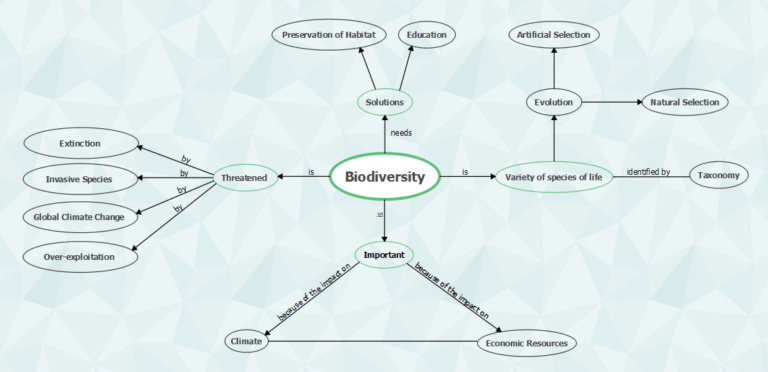
Biology concept map
Nursing
A great number of studies and research support the development and implementation of concept maps in nursing education. These discovered that concept mapping is an effective teaching technique in nursing education since it helps both to analyze and evaluate students’ thinking and knowledge. As an educational technique, concept maps have been used in nursing education for more than 25 years.
By using concept maps students could better understand how theory is applied to practice and therefore could prepare themselves for working in the nursing sector. In fact, when it comes to medicine, concept maps are an optimal way of dealing with extensive and valuable information when providing care to patients. Namely, concept mapping can help students in linking basic scientific principles with medical practices. Furthermore, by implementing concept maps as a learning approach, they could practice mapping out care plans for patients. In addition, it helps them visualize their existing knowledge on a particular case or topic, as well as make their learning processes about them more specific.
Psychology
It is known that problem-solving is a cognitive activity which is studied in psychology. Specifically, problem-solving is defined as “The process of finding solutions” to difficult or complex issues”.
Concept maps can be exactly used for problem-solving as they have the power to reveal relationships between one general central topic and numerous specific subtopics that branch out of it. When problem-solving, concept maps can be created as highly complex structures that illustrate a convoluted overload of information for a specific topic.
Although at first, they might appear difficult to follow, with time, concept maps can enable a substantial improvement of students’ performance much more than other teaching techniques.
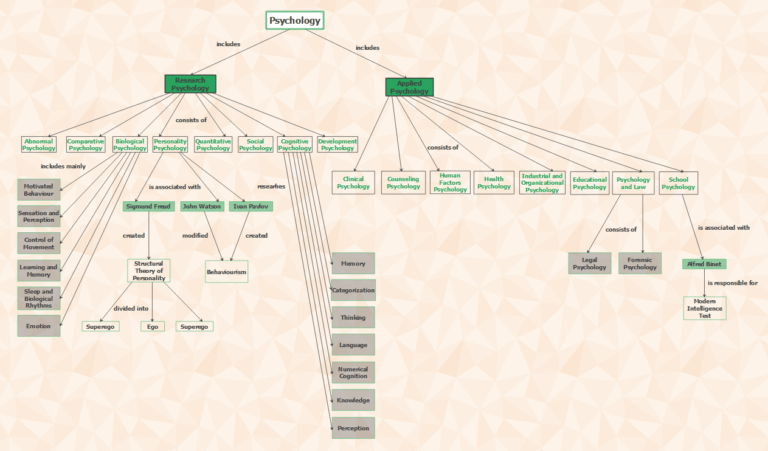
Biology concept map
Science
When introduced to new concepts in science, students aspire to combine existing knowledge and fresh ideas. Thus in the process of learning scientific concepts, they are in need of an approach that would simplify how they organize and synthesize important information.
Concept mapping can bring many advantages to students and educators while learning and teaching science subjects because it helps them to visually present connections between existing and new knowledge. Even though it seems challenging for them, after creating the concept maps on a different subject, students would be able to deeply analyze and understand interconnections and learn the material more effectively. In the end, they can discuss and elaborate the maps with each other and with their educators in order to determine whether there is a concept that is incorrectly presented. On the other hand, educators can use concept maps as teaching tools for practicing new science lessons. Moreover, teachers can use students’ concept maps as a testing method for evaluating how well a subject is understood by them.
Engineering
In the field of engineering, concept mapping is used as a method to help planning, designing and constructing structures. Engineers are known to combine their knowledge of science, mathematics, and economics with experience and skills in order to propose a solution to a specific problem. Sometimes they need to present, analyze and evaluate multiple different solutions so that they could decide the optimal approach to the presented problem.
Students who study engineering learn how to propose various ideas for one central topic with the help of concept mapping. Moreover, they are using them as a tool for illustrating all aspects of an engineering project. For example, creating a concept map on designing a specific structure could help in displaying all interconnections between the general topic and subtopics. The map would contain all the information needed for realizing a design project.
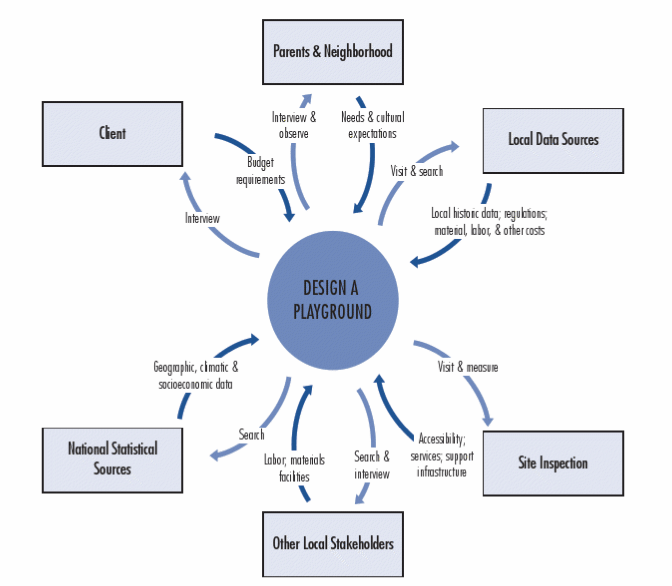
A concept map of playground design project. Image source: Queen’s University
How Can You Concept Map With iMindQ?
Through the years there were extensive discussions about the advantages and disadvantages of concept and mind maps, and the conclusion is that precisely because of their differences, both are techniques that will continue to be widely used in numerous contexts.
As a learning method that is applicable in educational environments, same as mind mapping, concept mapping can be practiced individually or in a group. However, in both cases, most of the time, concept maps are created with the help of concept mapping tools.
The reason why concept maps are developed with software applications is that they simplify the presentation of the ideas and concepts. However, today, since there are not many tools with the sole purpose of concept mapping, many mind mapping tools are designed with the idea to also function as concept mapping tools. Particularly, these mind mapping tools allow users, according to their needs, to create both mind maps and concept maps.
Such software is iMindQ – a mind mapping tool that can also be used for concept mapping. iMindq offers an adaptable template concept map which gives its users the opportunity to create concept maps on a wide range of topics.
